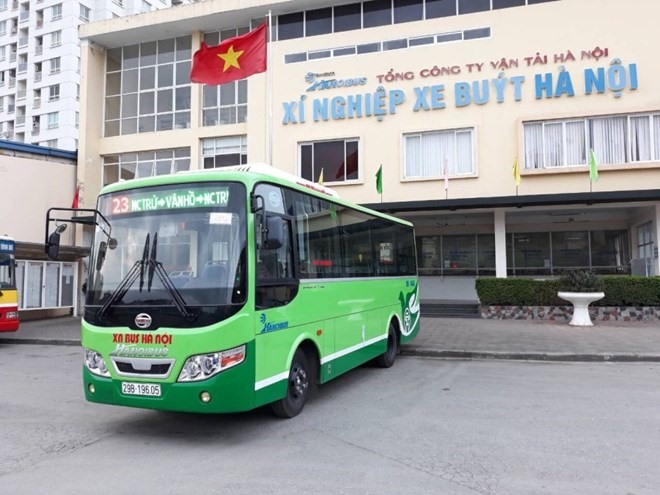 Society
Society

The number of passengers riding buses in Hà Nội has risen since late 2016, the Hà Nội Department of Transport said, but the system still faces major challenges as it seeks to attract more riders.
 |
| Bus No. 23 was recently replaced with a modern vehicle. – Photo vietnamplus.vn |
HÀ NỘI — The number of passengers riding buses in Hà Nội has risen since late 2016, the Hà Nội Department of Transport said, but the system still faces major challenges as it seeks to attract more riders.
At a press conference on Thursday, department director Vũ Văn Viện, said that in 2017, Hà Nội’s public buses transported 441 million passengers, up 1.9 per cent over the previous year.
In the first half of 2018, there were 221 million passengers riding buses, increasing 5 per cent compared to the same period last year.
“In general, the city bus services, including normal and subsidised ones, have grown,” he said.
Bus routes have expanded, including rapid transit buses and city tours which connect the 30 districts and communes.
Responding to the report issued early this month by Hà Nội Transportation Service Corporation (Transerco) showing a sharp decline in the number of public bus riders in the city, Viện said the study only covered subsidised buses.
In 2012, with 53 bus routes, Transerco served 414 million passengers while in 2017, with 74 bus routes, they only transported 321 million passengers, a decline of 93 million passengers. Moreover, transit time has also lengthened due to the rising traffic influx and road infrastructure.
Despite the declines in subsidised bus ridership, the total number of bus passengers has ticked up since late 2016.
Another 10 enterprises operate public buses without any price subsidies, which offer longer journeys. When both services are considered, the number of public bus riders has actually risen.
Nguyễn Thanh Bình from the Hà Nội People’s Council said that the decline in passengers on price subsidised buses could be tackled if the service providers paid more attention to reducing transit, including shortening the distance from passengers’ homes to bus stops. If travelling by bus takes much longer than other alternatives, it won’t be able to compete, he said.
Nguyễn Nguyên Quân, head of the Urban Department under Hà Nội People’s Council, said the public bus system currently meets only 13 per cent of people’s transportation demands, while the city is set aims to meet 20 to 22 per cent by 2020. In less than two years, it will be almost impossible for public buses to reach the target.
Therefore, Hà Nội Department of Transport is tasked with developing better solutions to tackle the issue as well as set more realistic and detailed goals.
Transerco, with its eight sub-agencies and three joint-stock companies, is in charge of operating many inner-city bus routes, accounting for 81.5 per cent of the city’s subsidised bus routes. According to Nguyễn Công Nhật, the corporation’s deputy director, the number of public bus riders reached its peak of 414.8 million in 2012 and started falling afterwards.
To improve services and attract riders, Transerco has launched new bus routes to increase connections within the city and to outlying areas since 2016. However, the lack of small buses which can access narrow streets is another challenge for the public bus system.
Quân recommended the corporation to improve supporting services from renewing vehicles to developing smartphone-based bus-tracking applications. The city’s authorities will also tighten management and create favourable conditions to improve the public bus system.
Nhật said that besides new vehicles, it is critical for social infrastructure to be improved. To reverse the passenger loss, buses need to win the speed game against private vehicles.
Without breakthroughs in infrastructure, such as specialised lanes for buses the rising number of bus routes will still fail to attract more passengers, he said.
In the past two years, Transerco replaced 320 old buses with new, modern ones. Fourteen new bus routes with three routes serving narrow streets are planned to open this year.
Mini-buses with a capacity of 20 to 24 passengers can access small, high-density streets, helping transport passengers from those areas to the main bus routes.
The corporation said meeting passenger demand in underexploited routes will help raise the number of public bus riders and ease traffic congestion. — VNS




